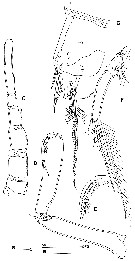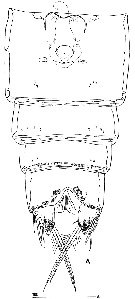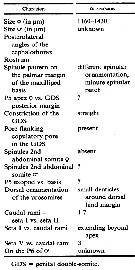|
|
 |
|
Harpacticoida ( Order ) |
|
|
|
Clytemnestridae ( Family ) |
|
|
|
Goniopsyllus ( Genus ) |
|
|
| |
Goniopsyllus rostratus Brady, 1883 (F) | |
| | | | | | | Syn.: | no Clytemnestra rostrata Giesbrecht, 1892 (p.568, 771, figs.F,M);
no Clytemnestra rostrata : T. Scott, 1894 b (p.106); ? Hardy & Gunther, 1935; ? Seno & al., 1963 a.; Vilela, 1965 (p.21, figs.); 1968 (p.44, figs.);
Clytemnestra rostrata : Berasategui & al., 2006 (p.485: fig.2).
? Sapphir rostratus Car, 1890.
No Clytemnestra rostrata : Monard, 1928. Mori, 1937 (1964) (p.118, figs.F);
no Gonopsyllus rostratus: Chen & al., 1974 (p. | | | | Ref.: | | | Brady, 1883 (p.107, figs.F, no M); Huys & Conroy-Dalton, 2000 (p.40, Redescr.F,M, figs.F,M, Rem. p.44); Boxshall & Halsey, 2004 (p.278, p.279: fig.F); Vives & Shmeleva, 2010 (p.99, figs.F, Rem.) |  issued from : Huys and Conroy-Dalton in Bull. nat. Mus. Lond., 2000, 66 (1). [p.38, Fig.26, C-G]. Female: C, A1 (armature omitted); D, Mxp (anterior); E, distal portion of basis and endopod of Mxp (anterior); F, P5 (posterior); G, anal somite and left caudal ramus (dorsal).
|
 issued from : Huys and Conroy-Dalton in Bull. nat. Mus. Lond., 2000, 66 (1). [p.40]. Spine and setal formula of P2-P4 swimming legs. Left P3 exopod 3 and right P4 exopod 3 aberrant outer spine number.
|
 issued from : Huys and Conroy-Dalton in Bull. nat. Mus. Lond., 2000, 66 (1). [p.41, Fig.28, A]. Female: A, urosome (excluding P5-bearing somite; ventral [distorted due to excessive squashing]).
|
 Issued from : K.H. Cho, W.-S. Kim & W. Lee in Proc. Biol. Soc. Washigton, 2010, 123 (2). [p.134, Table 1]. Diagnostic characteristics. Nota: Compare with G. clausi, G. dokdoensis, G. brasiliensis.
| | | | | Compl. Ref.: | | | in CalCOFI regional list (MDO, Nov. 2013; M. Ohman, comm. pers.); Zakaria & al., 2016 (p.1, Table 1, Rem.); Benedetti & al., 2016 (p.159, Table I, fig.1, functional characters); Marques-Rojas & Zoppi de Roa, 2017 (p.495, Table 1); El Arraj & al., 2017 (p.272, table 2); Benedetti & al., 2018 (p.1, Fig.2: ecological functional group); Acha & al., 2020 (p.p.1, Table 3: occurrence % vs ecoregions). | | | | NZ: | 5 + 3 doubtful | | |
|
Distribution map of Goniopsyllus rostratus by geographical zones
|
| | | | | | | | | | | | | Loc: | | | SW Atlant. (Brazil, Argentina), Bahia de Mochima (Venezuela), Ibero-Moroccan Bay, W Medit. (Alboran Sea, Balearic Sea), ? sub-Antarct., ? China Seas (Yellow Sea, East China Sea, South China Sea in W. Zhang & al., 2010, (pers. comm.), California region.
Type locality: 42°32' S, 56°29' W.
For Cho & al. (2010, p.135) the distribution of this species is limited to the South Atlantic (off the Argentinean coast) and the records in Korean waters in the previous studies are possibly misidentifications of the current new species Goniopsyllus dokdoensis. | | | | N: | 9 + 3? | | | | Lg.: | | | (931) F: ± 1,43; {F: 1,16-1,43} | | | | Rem.: | All locality records and the sizes indicated earlier are doubtful because of the revision of the genus by Huys & Conroy-Dalton (2000). For these authors G. rostratus can be readily identified from the other South American species G. brasiliensis by the large body size, the elongate caudal ramus setae IV-V, the long seta I clearly extending beyond the distal margin of the ramus, and additional differences in the ornamentation of Mxp (spinule pattern on palmar margin). Brady (1883) also illustrated well developed posterolateral extensions on the cephalothorax which are completely absent in G. brasiliensis.
Chen & al's. record from the East China Sea and Mori's (1937) from Japanese waters are indeterminable on the basis of the illustrations provided. The short female P5 suggests a species different from G. rostratus. Similarly, marques (1958) did not give convincing evidence for her record from Angola.
Identification characters after G.A. Boxshall & S.H. Halsey (2004, p.278):
1- Exopod of P1 with 3 distal setal elements; female A1 6-segmented.
2- Longer of 2 outer proximal bipinnate setae on female caudal ramus reaching well beyond distal margin of ramus.
3- Genital double-somite of female 1.35 times wider than long, with more-or-less straight lateral margins.
After Benedetti & al. (2018, p.1, Fig.2) this species belonging to the functional group 7 corresponding to small filter feeding herbivorous. | | | Last update : 24/10/2022 | |
|
|
 Any use of this site for a publication will be mentioned with the following reference : Any use of this site for a publication will be mentioned with the following reference :
Razouls C., Desreumaux N., Kouwenberg J. and de Bovée F., 2005-2025. - Biodiversity of Marine Planktonic Copepods (morphology, geographical distribution and biological data). Sorbonne University, CNRS. Available at http://copepodes.obs-banyuls.fr/en [Accessed November 28, 2025] © copyright 2005-2025 Sorbonne University, CNRS
|
|
 |
 |






